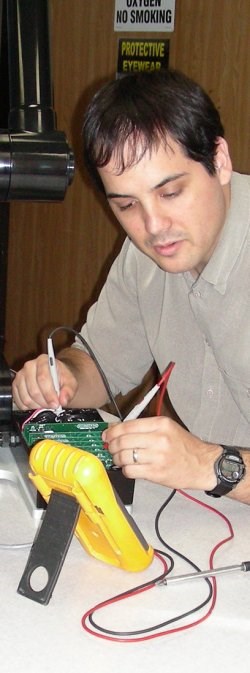NEWS RELEASE
LAKE SUPERIOR STATE UNIVERSITY
************************* LSSU engineering grad lives robonauts and rovers
SAULT STE. MARIE, Mich. – Tom Waligora's creativity has launched satellites into Earth orbit and may someday help humans explore the moon and Mars.
If that is not cool enough, the 2003 Lake Superior State University electrical engineering graduate [shown] has even mingled with the likes of Steven W. Hawking, the famous physicist.
However, Waligora knows when it’s time to wipe the stars from his eyes and return to a world that runs on deadlines.
"Right now I am working on a next-generation 5,800-pound rover through NASA’s R&D robotics group," says Waligora. "The plan is to build three vehicles, the last of which must be ready for desert tests this November at Meteor Crater, Arizona."
The prototype rover shakes out the technology required for remotely controlled or completely autonomous rovers that will follow astronauts around on walks around other words, like loyal pack animals carrying gear and essential supplies.
"The first rover is approximately 90 percent complete and is a simplified version that will be used as a test bed for subsystems such as motor drivers and active suspension," says Waligora. "The second rover is a more complete vehicle for verifying that the systems can work together."
It's the latest in a series of projects that Waligora has thrown himself into since being hired two years ago by the space systems division (OSS) of Oceaneering Advanced Technologies.
The Houston-based company designs everything from hardware for shuttle and space station astronauts to use on EVAs, to intricate mechanisms that eject satellites into orbit from the space shuttle or other space vehicles.
Other OSS specialties include thermal protection systems for rockets, and robotic systems for military, space, and biological research. The company supports astronaut training in NASA's Neutral Buoyancy Laboratory and Space Vehicle Mockup Facility at NASA’s Johnson Spaceflight Center in Clear Lake, Texas.
His first company project was a microsatellite deployment system for the Department of Defense's space test program, designed to fly in the space shuttle's cargo bay.
It use was successfully tested during a flight that Shuttle Discovery made to the Space Station last December.
"In a stunning display of grace, fluidity and agility, the system deployed two satellites simultaneously," says Waligora. "My project responsibilities ranged from proposal development and schematic/circuit design, to final testing and product delivery. It's very exciting to have something that I helped design get launched into space aboard the shuttle."
Another amazing, if not humbling, aspect of an engineer's job is teamwork.
Nothing would get done without a myriad of specialized skills.
"It's just not possible for a single person to build, let alone launch, flight-level hardware," says Waligora. "There are so many people involved, from quality inspectors, technicians, project managers, customers, vendors, and purchasers."
Waligora was also recently involved in a more down-to-Earth endeavor: the company's "Terabot" creation, a robotic arm that clips onto a variety of stationary or mobile platforms, depending on how it is going to be used.
Its dexterity is ideal for investigating and manipulating explosives without endangering an operator.
"The system has five degrees of freedom, a 25-pound lift capacity with a dust and water seal," says Waligora. "It's been used by law enforcement and military inspection vehicles, as well by astronauts as a training tool during NASA Mars exploration exercises in Arizona."
However, these days Waligora's pride and joy is his current assignment, the big rover and its milestone test this fall.
"Most of the people I am working with have advanced degrees from Purdue, MIT, and Carnegie," Waligora says. "I feel very fortunate that I was asked to join the team on this build."
Waligora's new teammates formed the core group that developed Robonaut, a humanoid robot that functions as a virtual EVA astronaut.
A human operator's hands and eyes, even his sense of touch, networks through Robonaut via a telepresence control system.
Waligora had a famous visitor to the Robonaut lab not long after he joined the crew. "Steven W. Hawking came to check out Robonaut, and I helped set up his demo," he beams.
Visiting relativistic physicists, plug-and-play robots, giant robomules . . . all the stuff of dreams. "I have the ultimate job for an engineer," says Waligora. "On top of all this my wife and I just welcomed Ally, the world's cutest baby, into our lives."
Call it proof-positive that dream jobs aren't the only source of all fun and joy, at least in Tom Waligora’s case. He has a wonderful personal life as well.
*************************
